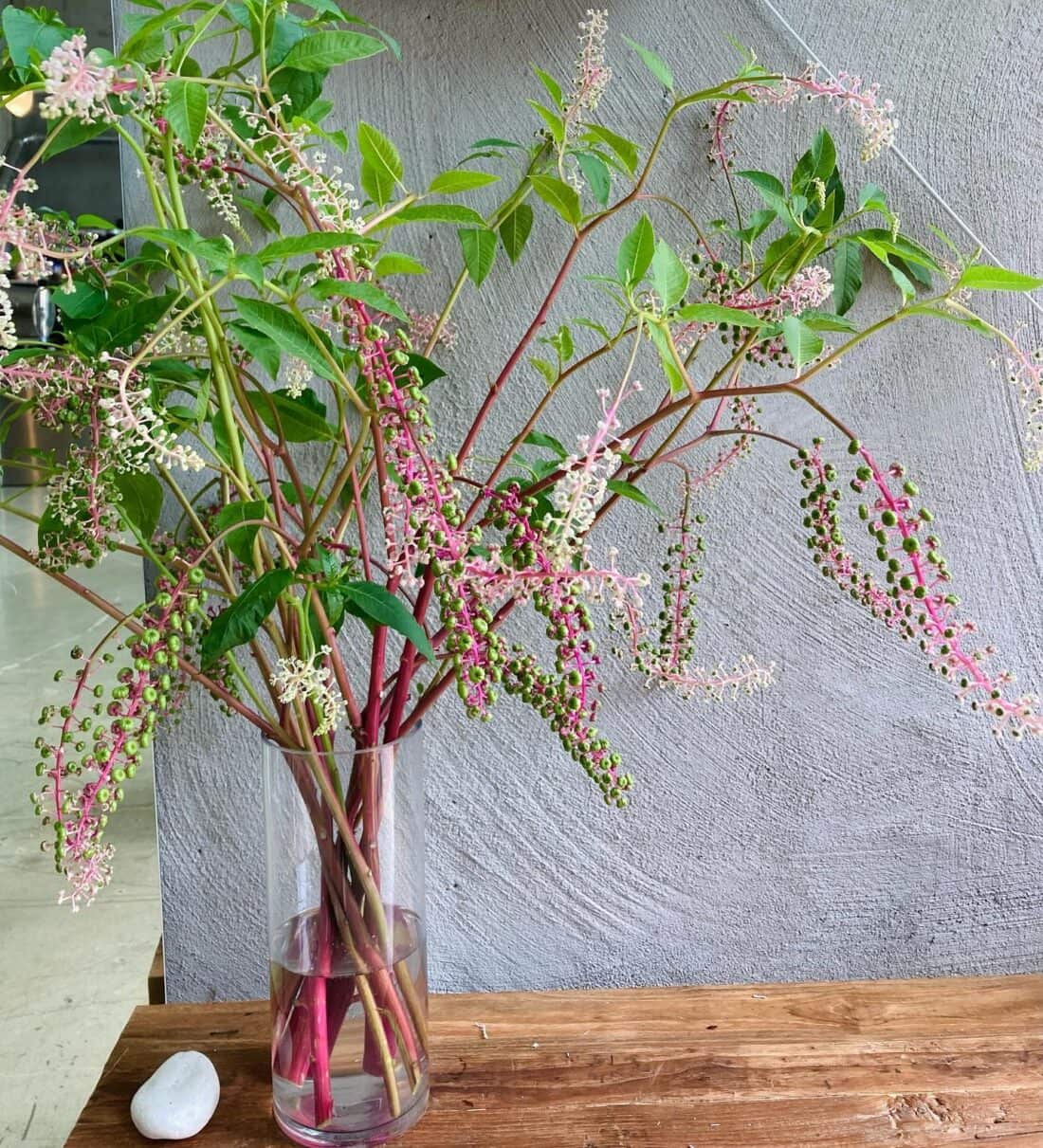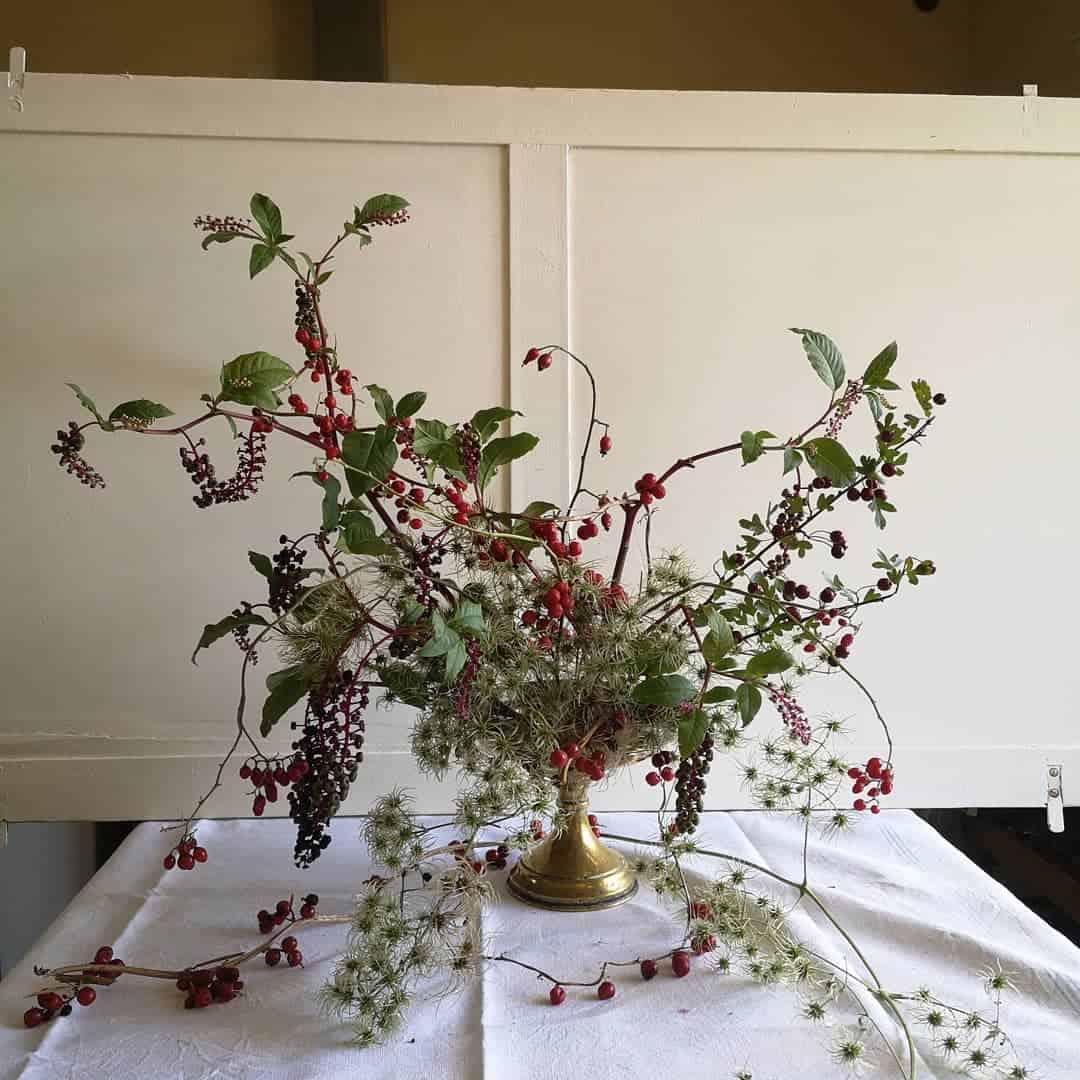When I first moved to my current garden, I was confronted with American Pokeweed. At first, I didn’t even know what it was. They were growing behind my vegetable garden and on my aging compost heap.
They were huge and happy (seeming), and they were on the fringes of the evolved areas of our garden, so I couldn’t bear to take them down, and I left them to do whatever.

I was pleasantly rewarded with beautiful berries in the fall. Still not knowing what they were, I started to use them in flower arrangements.
Over the years, I’ve had seasons of cursing myself for ever letting them grow freely and, more recently, finding a path to let them survive and thrive, but in a way that works for everyone (me, my family, the ecosystem I live in, and the design and feel that I like to maintain in the open areas around my home).

Eventually, I identified these curious species as native plants (to me, in New England) called Phytolacca americana (common name Poke, or Pokeweed). Poke isn’t invasive in general – but it can be very aggressive in disturbed areas.
My garden in the early days qualified as disturbed, so that explains how and why things went off the rails a little with the poke weed (for a few years).
About Native American Pokeweed:
Pokeweed (also called poke salat, poke root, poke berry, pigeon berry, inkberry coakun, pocan bush, scoke, poke salad, and American nightshade) is found across a huge swath of eastern North America and into the south.
(Interestingly, it is not native to the northern Rocky Mountian States, such as CO, WY, or MT, which explains why I had never come across it before living in New England).

In my quest to understand this rather happy plant and see if I can harness its virtues in a better fashion, I did a little research.
This is the most interesting stuff I found over at WaynesWord (this link is removed as the website has disappeared):
“Pokeweed (Phytolacca americana) is a robust perennial potherb native to the eastern United States. It belongs to the pokeweed family (Phytolaccaceae), a small family found mostly in Africa and the New World. In addition to pokeweed, it also includes several enormous South American trees and some unusual serpentine vines of the tropics. Poke is derived from the Algonquian Indian word “pakon” or “puccoon,” referring to a dye plant used for staining. It is sometimes spelled polk and the leaves were reportedly worn by enthusiastic supporters during the campaign of James K. Polk, 11th president of the United States. The generic name Phytolacca is derived from the Greek word phyton (plant) and the French lac (lake–a dark red pigment), referring to the crimson juice of ripe berries. Pokeweed may grow to nine feet tall, with large, alternate leaves and a carrotlike taproot. It may become a very invasive weed in southern California gardens and is difficult to eradicate when it becomes well-established. Greenish-white flowers are produced in long clusters (racemes) that droop due to the weight of ripening fruit. The flattened berries change from green to shiny purplish-black. Ripe berries yield a crimson juice that was used as a substitute for red ink and to enhance the color of pale wines. The coloring of wine with pokeweed berries has been discouraged because they are very poisonous.”
“Freshly cut young leaves and shoots may be cooked and eaten like spinach. They should be boiled twice, and the first water being discarded. In 1969, when astronaut Neil Armstrong walked on the moon, a popular song on the radio was “Poke Salad Annie.” The song depicted a poor southern girl who picked a wild plant called pokeweed for a vegetable. The greens are also called poke salet, and they are sometimes canned and sold in markets.”
Warning – the above claim for edibility should be checked before you eat them. Many experts report that all parts of this plant are inedible and poisonous. I do not recommend eating it. I leave the berries for the birds – they love them.

How I Accommodate Poke in my Naturalistic Garden
Phytolacca americana is undeniably eye-catching. It quickly grows from the root in the early summer to a tall and robust plant with various attractive ornamental features by late summer. As a perennial, it will grow back from its roots year after year. It will also get much larger each year.
If left to grow, the taproot will get bigger and bigger over a few seasons and will become quite large (at just 2-3 years old, it will easily be as large as a soccer ball at the top – in the first year, it will look like a large turnip).
You will not find it in the woods; it tends to grow only in open woods or along the forest edge. I get it in my vegetable garden becasue it is a disturbed area that is along the forest edge (both are ideal for this plant).
Poke has very pretty reddish stems. Racemes of whiteish flowers eventually turn into clusters of deep dark purple berries by the end of the growing season.
If you let these berries drop, the poke will spread and you may find you have more than you want. I highly recommend weeding out unwanted plants early – it is easier when they are smaller. That huge root is hulk to dig out when they are bigger.
Harvesting the Poke Blossoms
Poke is great in arrangements. The stems hold up well and add a lot of interest to both a collection of garden blooms and something simpler. Like just a large cluster of poke flowers, leaves, and stems.
By harvesting early, you will prevent the seed setting that will lead to potential unwanted spread.

The Berry stems are also very luxurious and eye-catching in arrangements – but be careful – they stain. Don’t use them where you might brush against them. They tend to work well in full and large arrangements that feature other blooms of the late summer (dahlias, asters, etc) as well as in ikebana-style arrangments that highlight their sometimes lanky stems.


Pokeweed in a Naturalistic Native-filled Garden
The best tip I can give you with this plant is to use it (or rather, let it grow when it volunteers) but keep your eye on it.
Using the flowers will help you control its spread.
Don’t let it go too far, and I’d hesitate to let it get too big. Dig out the biggest plants every couple of years and only let the smaller ones survive. (I’ve found that if you get the main core of the root – it will not come back – it is aggressive – but not that aggressive).
In a naturalistic setting, they are best grown where they want to grow – which is at the edges.
Because they are so tall (like 5 feet or more) and wild-looking, they are great for blending a more cultivated area into a wild or wooded area. They will give you lots of interest – much more than your average wild plant. You will naturally be drawn to the size, the blooms, the red stems, and the berries.
I’d let them mingle with other natives of their stature – like Golden Rod and Joe Pye Weed. This plant community will help hold each other up (structurally) and will look beautiful together with lots of yellows, pinks, and deep purples – it is truly a gorgeous natural arrangement.
WOW ..we are on the same botanical-line… perhaps witches
kiss Dana
Living down south for 11 years, we had neighbors who used poke (before it became 1′ high) for spring greens (high mineral and calcium content) cooked with fat back. Then with fall the berries became body paint for our kids- seeds are the toxic part- so they were always told not to eat but the juice made a great stain! Then the old folks would harvest some root after the plant went dormant and chopped small, made into a tincture (steeped several weeks in 100% alcohol) for stimulating the immune system, defense against colds and flu, so they said. Russian, Native American and contemporary herbalists all list it as beneficial. Your own backyard pharmacy. Versatile, healing, fun and beautiful! Lovely arrangement dana!
http://www.herbalremediesinfo.com/poke.html
Check this pokeberry ink out! I’m SO doing this! http://www.curiousgood.com/?page_id=324
Please be careful. Pokeweed is very poisonous–the whole thing, not just the berries. It’s a plant that may be beneficial, but it needs to be treated with a great deal of respect and considerable knowledge.